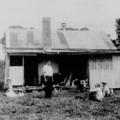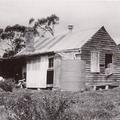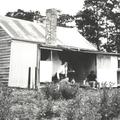< Early Canberra Government Schools
Royalla School [1879 - 1935]
Previous Name/s: Rob Roy (until 1892)
Rob Roy opened in May 1879 as a Half Time school paired with McDonald's Flat. In January 1879 a letter on behalf of the residents claimed that there were 'fifteen children from four to fifteen years of age' and promised that 'we are willing to provide premises and furniture suitable for teaching purposes'. Andrew Douglas Wright was the first teacher, and stayed for nearly two years. When he left, the school remained closed for four or five months until his successor, John Ahern, was appointed in August 1881.
At the end of 1891 seven of the parents (including Curran, Sheedy, McIntyre) in the Rob Roy district made application for a new school to be located two and a half miles to the south along the Cooma road, at Guises Flat, promising that their children, 28 in all, would attend – sufficient for a full time Public School. Other families who would find themselves further away from the school, objected however (Wallace, Bunt, F.Blewitt and Mrs. Blewitt). With characteristic deftness Inspector Cooper recommended that a new Williamsdale school be provided 3/4 mile closer to Rob Roy, and that both schools be upgraded to Provisional School status. Mr J. Mayo was named as the 'correspondent' for Rob Roy.
Inspector Cooper observed in his advice to the department that "the settlers at Williamsdale are likely to be permanent and therefore the expenditure of (say) £45 would be warranted. At Rob Roy however, [a number] of the pupils are the children of Railway fettlers who may change their residence at any time". He also notes that: "The Rob Roy school is on private land and it will probably be necessary in the near future to remove it to a Government Reserve about a mile further from Williamsdale. For the present, an expenditure on that account need not, I think, be incurred".
The Cooma railway line (later known as the Bombala line) south from Goulburn was opened in stages to Tarago (January 1884), Bungendore (March 1885), Queanbeyan (September 1887), Michelago (December 1887), Cooma (May 1889), Nimmitabel (April 1912) and Bombala (November 1921). In advising how a teacher sent from Sydney should travel to Royalla, Inspector Cooper advises "by rail to Rob Roy Platform, on the Cooma Railway line. Care should be taken to give this information, as it stands, to the teacher appointed. 'Royalla' is merely the Departmental designation of a well-known Railway Platform on the Goulburn and Cooma line". An early timetable indicates stops at Tuggeranong, Royalla, Williamsdale, Michelago, Bredbo, Chakola, Bunyan and Cooma.
Rob Roy became a full time Provisional School in June 1892 (McDonald's Flat meanwhile had been re-named 'Williamsdale'). In August 1892 Rob Roy itself was re-named 'Royalla'. After being threatened with closure in 1894, in January 1897 Royalla was again reduced to a Half Time school, now with Waterholes School – to ensure continuity of provision there. Archibald McDonald, John Mayo, Samuel Baldwin, George Bunt and Peter J Becker wrote complaining to the Minister about this downgrading, to no avail.
Then unexpectedly the school had to close in the following month (February 1897) when the teacher, Joseph Nickson, reported that the owner of 'Rob Roy' station, Mr McDonald, refused to allow the continued use of the school site on his land, and demanded that all the 'school material' be removed. Inspector Cooper asked the teacher to 'have Departmental property placed in safe keeping' and as the residents had a claim to the school building, to consult with them 'as to whether they will remove the building to the site on Crown Land, dedicated for school purpose, or provide another room, so that the school may be continued'. McDonald responded that 'he would allow no one to touch any of the buildings'; Bunt and Mayo opined that pressing the claim 'might cost them more than the building is worth'. Nickson reported to Inspector Cooper that 'Mr John Mayo of 'Roby Roy' agreed to remove, provide storage for, and look after the property for the sum of ten shillings'. The teacher was authorised to teach full time at the Waterholes School 'pending arrangements being made for his removal to another position'.
John Mayo put pen to paper to complain at the injustice of Royalla being downgraded to Half Time status, arguing that 16 children were ready to attend (Mayo – 3, Bunt – 4, Baldwin – 5, Becker – 3, McDonald – 1), 'with the prospect of another family coming to take charge of a Railway gate close to the school'.
The school eventually reopened in November 1900 once more as a Half Time school with Willliamsdale. Alexander Trotter was the teacher, having effected an exchange with Mr C McAlister, who left Royalla to take Trotter's place at Majura. In July George Wilson had written to Inspector Cooper saying that after consulting with other parents they had decided 'to purchase a galvanized iron building now standing at Tuggranong platform and have it erected on the school site.....If you will forward a plan of the school site we will have it built as quickly as possible'. Tenders were called 'for the erection of a school building at Royalla School Reserve' on 22nd August 1900. The Reserve consisted of Portions 163 and 164 (school paddock) Parish of Burra.
In 1906 Inspector Thomas Walker recommended that the school be expanded: "The building is only 15' 6" x 13' 6" x 7' 6", which by allowing 12 sq ft to each child, gives floor space for only 16 pupils. The enrolment last quarter was 26 with an average of 17.3, and the present enrolment is 27....I propose to extend the building 9' 6" to give a room 25' long and 13' 6" wide which will afford accommodation for 28 pupils". The contract, for £34.17.4, was given to Cornelius O'Rourke of Queanbeyan. The Queanbeyan Age reported on 1st October 1907 that the school had been subject to an arson attack - foiled when the fire in the porch was discovered before it took hold on the building.
In July 1904 it became a Public School and remained so for more than twenty years, before again going Half time with Williamsdale (1927-27). The Queanbeyan Age reported on a 'red letter day at Royalla' in May 1905 when the annual picnic of the Royalla and Williamsdale schools took place, with visitors from Michelago, Tharwa, Tuggranong and Canberra. 'Too much praise cannot be heaped on the teachers Miss Hayley and Mr Coleman. They were ably assisted by Mr W Bates and Mr Jas Keefe'.
Everything became more complicated after establishment of the Federal Capital Territory. In May 1920 NSW Premier John Storey wrote to the Commonwealth Prime Minister, copy to the Secretary, Department of Home and Territories advising that the NSW District Inspector recommended that the school be refurbished - 'ceiling, floor verandah, general repairs and painting'. In June the Works and Railways Department gave approval for works to the value of ₤45; in the event ₤44.18.1 was spent. The work was completed over the christmas holidays
In June 1927 it became a Provisional School, but reverted to Half Time status (with Williamsdale) in May 1929 until it finally closed in July 1935. In November District Inspector Thomas Mute records in a Minute to the Secretary, Department of the Interior that three options were offered to the remaining pupils:
1. Conveyance to Williamsdale, with a subsidy of 5d per day, or for pupils riding a horse, 4d a day.
2. A subsidised school. A subsidy of about ₤11 pa per pupil to a maximum of ₤120 pa. Use of royal school building would be allowed and 'certain material supplied', but parent would have to find accommodation for the teacher.
3. Enrolment in the Correspondence School, Blackfriars, Sydney
Parents were encouraged to set up a committee and enter into discussions on these options. Evidently use of the school was not taken up as in March 1936 it was agreed to lease it as a residence for Mr Burke at ₤5 per annum ("It has been ascertained that Mr Burke, who is a relief worker, is of good repute"). The judgement was made that "The building will not be required for school purposes for an indefinite period on the basis of the present population".
School picnic and sports day at Rob Roy. By our Special Reporter
Nobody seems to know how Rob Roy got its name — or why. Surely the christening of it must have been done by some early-days Scot who'd not forgotten the legends which fit like a halo about the memory of the famous Macgregor and the wild hills of Scotia whose fastnesses were his stronghold in the days of his outlawry. However that may be, no more picturesque spot for the holding of a picnic could be found if you searched for a year and a day; and in addition to the natural advantages, the organisers of Saturday's picnic and sports were rewarded with an ideal day for their pleasure making, and an ideal crowd of pleasure seekers, too.
The Rob Roy school teacher, Mr. T. A. Trotter, acted as secretary and general manager of the picnic. and the day's pleasure-making was materially enhanced by the rapid and systematic manner in which he put through the various events. Unnecessary delay in working down a programme often spoils a days pleasure, and there was no delay at Rob Roy. The ladies had prepared a plentiful repast, and at 1 o'clock — just as The Leader representatives arrived on the scene — snow-white cloths, laden with all that one could desire in the way of edibles, were spread under the trees and the good things rapidly vanished before the attack of a very willing crowd, for at a time like that both juveniles and adults make their presence felt.
The events were numerous, and all of them were well contested. There were no money prizes, useful trophies being the order of the day. There was no 'running stiff'— every competitor was a 'trier.' Several prominent features of the day were the boys' running high jump which was won by R. Wallace; pole vaulting for boys, won by the same competitor, with a fine display by George Wallace - a little chap nearly a head shorter than his competitors; the girls' high jump, won by Vivian Blewitt, over a 4ft, bar — which someone wanted to say was a better performance than the Tuggranong hurdle racers were capable of; the pole vaulting for girls, where the same girl negotiated the 4ft. 11 mark and the ladies' races. Writer heard one fair competitor boast that she'd got a prize for running a good last. Of course, there were events for mere men — but they don't count.
At the conclusion of the sports, the teacher, Mr. Trotter, briefly thanked all present for their attendance and for the way they had helped to provide a day of pleasure for the school children. He especially desired to thank the ladies who had done the catering in such a creditable way. Cheers were given for the ladies — and for Mr. Trotter. Mr. Foster Smith returned thanks on behalf of the Williamsdale visitors for the enjoyment with which they had been provided, and Mr. Holland similarly spoke on behalf of Queanbeyan visitors. After which more cheers were given for Williamsdale and Queaubean. Prizes were distributed among the scholars attending Rob Roy school, every scholar receiving some useful present. As the sun dropped behind the everlasting hills, the tea bell rang, and a happy crowd once more made a markedly successful effort to lighten the burdens the caterers would have to take from the picnic ground. Then the children vanished homeward to dream of next year's picnics.
The Leader representatives formed part of a company pleasantly entertained for an hour at the hospitable home of Mr. and Mrs. Goodwin; and by 8 o'clock most of the adults were assembled at Mr. E. Morrison's residence, where the 'sounds of revelry by night ' awakened the mountain solitudes. The young people danced—and sang. The old ones (writer was one of the old 'uns) practised for the euchre tournament, which takes place on Wednesday night in aid of the Mclnnes Benefit Fund. For the dancers Mr. E. Morrison was M.C., while the musicians were Messrs. M. Morrison and Elliott. Songs were rendered by Mr. W. Hatch, Mrs. Goodwin, Mr. Elliott, Mr. Todd, and Master Harold Roberts.
The two latter gave comic items, Mr. Todd's 'Oh, let be it soon' and Master Roberts' 'Turned it over to Riley ' being very much appreciated. It was nearly midnight when we started for home, and the dancers were still going merrily, and thoroughly enjoying the treat provided by Mr. and Mrs. Morrison. Needless to say, the Queanbeyan visitors negotiated another meal (the fifth that day !) before leaving. An hour's run landed us home. We cycled slowly enough down the Stringy Bark Hill ('remembering the day (a score of years back) when Bob Dean guided his madly-racing team down its winding slopes to where, in the sandbed at the turn, coach and horses were strewn in a confu sion of wreckage. A grave stone in the cemetery by the river, and an Act of Parliament on our Statute Book mark the epoch of that disaster; and we had no desire to have history written over again in a similar way.
[The Queanbeyan Leader, Tuesday 23 May 1905]
Getting fenced in
Fred Cleaver, teacher in charge of Royalla 1917-1922, wrote to the Commonwealth Surveyor General in Melbourne - J.T.H.Goodwin Esq - on 2nd March 1921 requesting fencing for the school and school grounds. It was an eloquent and compelling letter - and had the desired effect:
Public School, Royalla,
via Queanbeyan
2nd March 1921
Dear Sir,
The above mentioned school is in the Federal Territory. The school ground is unfenced, and I desire to put before you the inconvenience caused by this condition, and also to submit to you a proposal to remedy the deficit.
The school is situated on a piece of elevated land and a porch with an opening of seven feet faces N West. In the winter the cold westerly winds cause the children to have a miserable time. The school is the only shelter from the cold Westerlies, and the intensity of the coldness can be understood from the fact that the ink froze in the wells twice during one day, at about 10 o'clock, last winter. You may imagine the feeling of the children under such conditions.
A flock of about 50 goats roams the local reserve, and during the Winter months they often break into the porch at night time, despite our efforts to keep them out. This means that the porch becomes shockingly dirty, and an offensive odour remains for a week after they have paid us a visit. Besides this, they often break into our little school garden plot and destroy the efforts of perhaps months.
If your Department will be kind enough to supply enough netting and wire I can arrange with the parents to erect a fence around the School. One side is bounded by a netting fence, and we propose to enclose about 3 1/2 acres (providing of course, that this scheme meets with your sympathy and approval. After careful measuring we ascertain that about 20 chains of fencing would enclose the remaining three sides.
I feel confident that, once the fence is erected, I could get the Western side ploughed by one of the parents, & we would be able to plant pines as a breakkwind, during the conning winter, and by planting shrubs also, the ares could be soon transformed into one of comfort and beauy for the children.
Would you be kind enough to inform me early, if your Department will help us by supplying the netting & wire, so that I may make arrangements with the parents to immediately split and erect the posts
Your faithfully,
F.W.Cleaver
Teacher-in-charge
The Surveyor-General's support was advised within the week - including the observation that 'Mr Weston may be able to assist with planting'. District Surveyor Percy Sheaffe recommened that a quote from Messrs E and W Blewitt for 12/6 per chain (erected) be accepted forthwith, as they were finishing another job in the locality, and added the note: "Charge against Rabbit Destruction - approved". [see the contemporaneous school photo]
Location Map
Teachers
- Wright, Andrew Douglas
05/1879 - 03/1881 - Ahern, John
08/1881 - 04/1884 - Rex, Richard
04/1884 - 11/1885 - Campbell, Silas
12/1885 - 12/1890 - Barbarie, Oliver C.
01/1891 - 05/1892 - McShane, James J.
08/1892 - 05/1894 - Nickson, Joseph
07/1894 - 03/1897 - Trotter, Alexander (Thomas)
11/1900 - 08/1906 - McAlister, Clement M.A.
08/1906 - 04/1908 - Fenton, Mary Ann
04/1908 - 01/1909 - Cameron, Annie Mabel
01/1909 - 10/1909 - Hayley, Miss Ruth
10/1909 - 08/1912 - Hutchinson, Miss Ethelwyn
10/1912 - Byrne, Cecil John
10/1913 - 07/1915 - Kemp, George Henry
09/1915 - 12/1915 - Ward, Bernadine
01/1916 - 05/1917 - McDonald, Mary
05/1917 - 05/1917 - Cleaver, Frederick W.
05/1917 - 01/1922 - Viney, Henry
01/1922 - 02/1922 - Ryan, Leslie W.
02/1922 - 09/1935 - Peacock, James
09/1925 - 06/1927 - Keeling, Gray
06/1927 - 05/1929 - Laing, Mr John
05/1929 - 04/1930 - Broadhurst, Arthur
04/1930 - 05/1932 - Gill, Horace Edward
05/1932 - 07/1935
NSW Government schools from 1848
- Royalla School (external link)
< Early Canberra Government Schools
If you are able to assist our work of identifying, documenting, and celebrating the early bush schools of the Canberra region, please contact us or .





